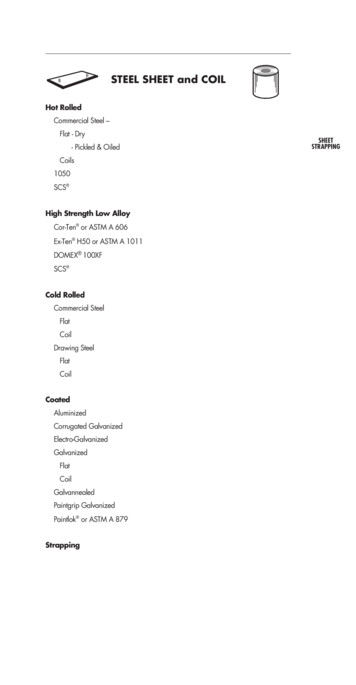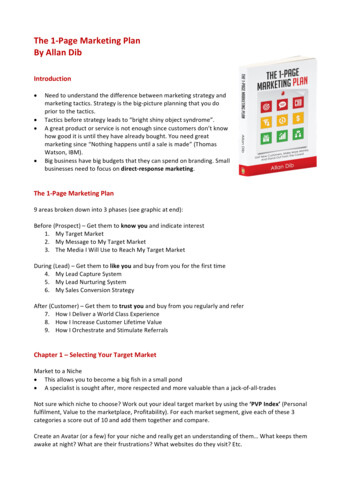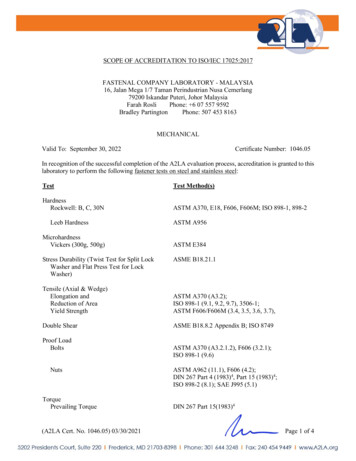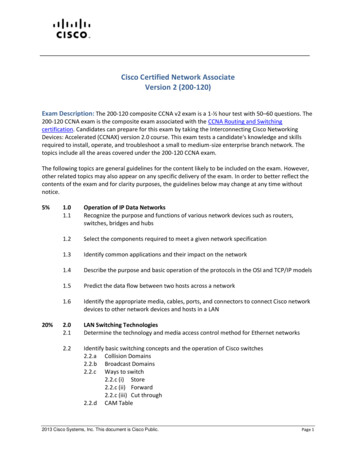![[120 Tactics & Strategies]](/img/18/placester-real-estate-marketing-guide-ebook.jpg)
Transcription
1
This is a complete guide toreal estate marketing in 2021.[120 Tactics & Strategies]In this new guide, you’ll learn exactly how touse marketing to promote your real estatebusiness, including: Real estate branding Website optimization Offline marketingSEOEmail marketing Social media Online reputation signals Listing promotionBlogging, video, and lots more2
Who is this for?You are: A real estate agent, office manager, managing broker, admin,tech lead, or anyone who is interested in improving the way youmarket and promote real estate for your business.Knowledgeable about the process of buying and selling realestate. You’ve worked in real estate, in a brokerage, with otheragents, brokers, admins, and assistants, and you are lookingfor new methods to deepen your marketing skills.Interested in marketing tactics, tools, and strategies to bemore effective generating new business, getting referrals, andstaying top-of-mind with the business you have. You are eagerto learn more, while recognizing that there are no silver bullets.You want: A greater sense of impact and control over your buyer and seller pipeline.A more focused, less reactive way to promote your business.To create a system for marketing your business that is less reliant on advertising. To be super effective supporting others with their marketing. To be strategically driven instead of letting the next shiny object drive you in circles. More options to respond to unpredictable business challenges,while ensuring your efforts are continually building on a strongfoundation.A shared language and common understanding about marketing goals, strategy, and tactics.3
By the end of reading this guide,you will: Understand the purpose of a good marketing strategy. Be able to define and prioritize marketing tactics (and relatedactivites) to promote your business. Understand the elements of consistent brand building.Be able to identify and address common marketing traps.Be able to collaborate with others on marketing.Be able to effectively communicate your marketing needs whenhiring help.Understand how to consistently improve your marketingUnderstand how to measure your marketing success.Be able to adapt and improve your marketing as circumstanceschange.Let’s get started4
Table of contentsChapter 1Real estate marketing fundamentalsChapter 2Establishing your brandChapter 3Traditional marketing tacticsChapter 4How to optimize your websiteChapter 5Real estate specific SEOChapter 6Email marketing tacticsChapter 7Social media and networkingChapter 8Reviews and trust signalsChapter 9Listing promotion6815Chapter 10Advanced blogging tacticsChpter 11Leveraging real estate videoChapter 12Iterating and improving your strategy4548512125343742435
Chapter 1Real estate marketing fundamentalsPicture this: in 2019 there were 5.34 million existing homes soldplus 682,000 newly constructed homes, according to the NationalAssociation of REALTORS ’ “Quick Real Estate Statistics.” That’sover 6 million homes — and there are about 2 million real estatelicensees in the country.When you do the math, even generously including new construction sales, it’s clear that real estate is a cutthroat business, and onlythe best agents will capture enough clients to survive long-term.Real estate agents might not immediately understand why marketing is critical to their success — but it is. Marketing is simply theact of sharing goods and services with an audience who might beinterested in buying those goods and services; the better you canpromote your goods and services to a receptive audience (as opposed to one that’s not interested in what you have to sell), the moresuccessful your business will be.6
When done well, marketing highlights the unique value that youbring to the table, showing specific buyers and sellers exactly whyyou’re the best choice for them. This means you probably won’tbe the ideal choice for everyone — marketing means making sometough decisions about who your audience is and how you want toreach them.Marketing is especially complex for real estate agents becauseyou're selling both services (your ability to help a buyer or sellerclose a home transaction) and goods (actual homes for sale). As abusiness-owner, you’re marketing in order to find clients who youcan represent in a home sale, and to find qualified buyers who areinterested in making an offer on your listings.This guide will walk you through everything you need to create amarketing strategy for your real estate business, step-by-step.7
Chapter 2BrandingWe all know what branding is, simply by virtue of living in moderntimes: A brand is the collective symbolic values and attitudes of acompany. Examples of good branding include the golden arches(McDonald’s) or the swoosh (Nike), both of which evoke differentthoughts and feelings when you think about them.It’s not just about the logo being identified with the company, butalso the fact that when you see golden arches, you probably thinkabout drive-throughs and Happy Meals and combo upgrades andpossibly, in 2020, coffee. And when you see a swoosh, you probably think about athleticism and trying hard and perseverance andpossibly, in 2020, political controversy.Now, you might not ever be as well-known as McDonald’s or Nike,but you should still think about your brand. How do you want yourbuyer and seller clients to feel about you and your services? Howdo you want prospective buyers to feel about the homes you listthat they tour? Finessing your branding will ensure that you’re incontrol of the feelings your clients have about you and the relationships you have with your clients.Step 1Develop a value propositionIf you want to be a successful agent, you should not only haveunique characteristics that set you apart from the competition,but you should be able to define what those unique features meanto your clients, leads, and community. A short value propositionshould exhibit your value and strengths as an agent. This statement will be reused in your marketing materials again and again.Ask yourself what makes you unique. What do you bring to the table that other agents don’t? Is it your experience? Your personality?Your knowledge of the area? Or something else?8
It’s possible that you bring skills from a past career that are invaluable to you as a real estate agent, or that attributes others mightlabel as flaws are actually secret superpowers in your arsenal. Forexample, maybe working in health care gave you the ability to handle even the most outsized emotions calmly, which might makeyou an ideal agent for high-stress sales involving divorce or contentious estates. Or maybe your introversion makes you a good listener, which you can emphasize in your value proposition.Step 2Identify your target customerMarketing alw ays works best when its messaging is focused on aspecific segment of your overall market. For example, your marketing will need to speak one way to investors and an entirely differentway if your target customers are first-time home buyers.Ideally, there will be something about your target customer thatties into your value proposition. Why does this particular group ofcustomers need your services? What is it about you that makes youa perfect choice for them?9
Resist the temptation to make your target customer overly broad.You can’t be everything to everybody, and you’ll be limiting yourown voice if you try. You also don’t want to get too specific if thatwon’t serve you well; there’s no sense in specializing in condo salesif there’s only one condo unit in your town!10
Step 3Develop a strong real estate agent bio and addit to your “about” pageNow you know who you are, what you do, and for whom you do it— so put it together in a bio that’s clear, easy to read, professionally written, and can be used across all of your professional platforms. When buyers and sellers find your brand online, they shouldbe able to get a strong sense of your professional qualifications andpersonality. Use a self-timer or get a friend to take the photo. Cheat: Use a photo of someone or something you love to generate a warm smile if you feel self-conscious. Test out different facial expressions and poses.Step 4Get a professional headshotYour bio isn’t the only thing that can provide consistency and coherence to your brand; you’ll also need to come up with a personal photograph that exudes a friendly demeanor and elevates yourbrand with a professional look. Hire a professional photographerwho can provide tips on positioning and who can make sure the final product is crisp and presentable in a variety of formats.If you’re low on funds early in your career, you can also opt to takeone on your own that looks professional. Here are the basics: Polish yourself up: Put on makeup and nice, tailored clothing sothat you look your best for the picture.Find your scene: You want a solid-colored background withgood light that’s not too harsh.11
Step 5Decide which marketing channels to useWe’re going to cover a lot in this guide, but not every channel willmake sense for every agent or every audience. Traditional marketing might not be the best opportunity if you’re trying to target entry-level buyers in a big city with a large tech scene; in that case,you probably want to think about digital market and social mediato really capture that younger, tech-savvy demographic.It’s very difficult, if not impossible, to find the time to use everyplatform and optimize every channel effectively, so choose whereyour time will be used best.Will you use a website? Will you blog often? Will you use Facebook,Twitter, YouTube or another social media option?Select the marketing channels that make the most sense basedon your personality and other skillsets. Start with what will makeyou feel most comfortable and what you’ll actually do — you canalways venture out of your comfort zone later.12
Step 6Step 7An elevator pitch is a 30-second pitch to use when talking to newleads — essentially, something you can tell them about who youare and what you do in the time it takes to travel together in an elevator.Now that you have an idea of who you want to reach, what youwant to say, and how you want to reach them, think about some interesting or quirky ways you can add a personal touch to your business cards, email signatures, social media accounts, website, andother marketing channels that will help identify you and differentiate you.Prepare your elevator pitchIf you created a value proposition (above), you can think of apitch as something very similar. But how things are read on paperdoesn’t necessarily translate well to personal interactions.Infuse your brand with a personal touchIn your initial conversations with leads, you should be able to makea brief but powerful statement that conveys you’re a knowledgeable agent who knows the market better than anyone. Once you’vecreated your pitch, practice it out loud13
People like working with other people. If you can give them aglimpse of who you are as a person (include your pet in your branding? share your music obsession in your videos? consistently referto your favorite sports team in your blog posts?), they’ll be morelikely to want to work with you.Step 8Have a unique signature item or lookBy the same token, many agents have a distinctive look, whether it’s a color they wear often, a style of dress, a hat, or hairstyle.Develop a positive, distinctive factor for your personal brand that isrecognizable and memorable.Step 9Get some swag printed with your brandingBrand exposure in your area can help grow your business. Getitems like calendars, pens, keychains, and notepads, and have yourname, logo, and contact information printed on them to pass outto clients or at local events.14
Chapter 3Traditional marketingBy “traditional marketing,” we simply mean marketing pre-internet. For many agents, this is still a quite lucrative and importantpart of their business, so if it makes sense for your niche and targetaudience, you may want to consider some or all of the followingtraditional marketing tactics.Step 10Step 11Sponsor local eventsLocal festivals, churches, schools, and sports teams are constantlyseeking sponsors. Look into fees in exchange for brand advertisingon booklets, T-shirts, banners, flyers, and so on.Establish partnerships with local areabusinessesDevelop relationships with local businesses and request to putyour real estate cards or listing information at their desk or bulletin board. Maybe you can keep real estate fliers and brochures atthe local pizza place in exchange for always delivering pizza to yourbuyers on move-in night?15
Step 12Host free seminars on topics concerning buyersor sellers in your areaDon’t just offer value to locals when you have a listing on the market. Find areas to host informal sessions to offer your knowledgeand advice to locals. Use a sign-in sheet to collect information soyou can follow up with attendees after. Libraries are often willing tooffer free space for these types of events.Step 13Advertise your business and listings in localmediaAdvertise your brand in local media like newspapers, magazines,radio, television, or whatever outlets are available to get your messaging in front of local buyers and sellers.Step 14Take local sponsorships to the next levelBe creative with local sponsorship opportunities: Sponsor the coffee mugs at your local coffee shop, the golf tee boxes at a golf club,or a stand at your local farmer’s market.16
Step 15Run an open houseYes, an open house can be a marketing tool — when done right.The key is to develop open houses where you can interact closelywith buyers (or even the lookie-loos) passing through and provideintimate walk-throughs.Make sure the house is staged well, and offer packets about theproperty and free swag with your company logo. Collect information via an open house sign-in sheet, and follow up with leads theday after your event.Step 16Use custom banners, balloons,and signs to advertise your open houseBuild brand recognition every time you host an open house by providing signage and other extras so everybody knows exactly whereto go. Then go the extra mile by putting your brand name or logoon them.Step 17Create a high-quality physical mailerMailers can help get listings and your brand in the hands of everyone in your community. Use high-gloss paper and sophisticated design to generate premier real estate mailers for your area. Thinkbeyond the “just sold” or “just listed” announcements and try toprovide information and details that will inspire recipients to hangyour mailer up on their fridge or pin it to the family bulletin board.Here are some ideas.Step 18Write a consistent column for your local mediaWriting a regular column in your local newspaper, magazine, oronline blog will help you present your knowledge to an audiencemost poised to buy or sell (from you) and will also build your brandrecognition in your community. If you’re a better talker, add yourthoughts to a regular radio show or podcast.Step 19Attend local events and join local meetupgroups and associationsBeing a force in your local community means showing up in places where you can build real face-to-face relationships. Use localgroups, festivals, or meetings to grow your contact base. Real estate organizations are always a good place to start, but considerjoining groups or meetups that interest you personally — an amateur sports league, a toy-collecting hobby group, a regular pokernight, whatever will get you in the door (and keep you attending).Meetup.com and Facebook groups can be two ways to find localgroups of interest for you.17
Step 20Get some out-of-the-box business cardsBusiness cards will never go out of style. You’ll always have in-person meetings and run-ins with buyers, sellers, and other industryprofessionals, meaning it’s vital to have your information on handto share with them. A boring card that lists your business name andcontact details in the smallest, plainest font won’t be memorable(and the recipient might lose it). Take a risk and order some originalbusiness cards few have likely seen before. From gold-foil details tocards you can plant, there are endless opportunities in 2020.18
Step 21Step 22Think for a moment about what you normally get in the mail: mostly bills, right? When you send a buyer or seller prospect or client ahandwritten note, what you’re really delivering is an opportunity todelight them with an unexpected experience.Let’s face it: Moving sucks! There’s so much you can do as an agentto make it smoother and more enjoyable for your buyers and sellers, such as:Write handwritten notesCombine this strategy with the home valuation tool mentioned below for sellers — send handwritten notes to any home valuationleads that failed to enter their email address and invite them toreach out for a solid dollar amount, or send them some other pieceof information that might be relevant right now (such as averagedays on market in their neighborhood).Go above and beyond for clients during andafter the move Arrange their moving truck Send a handyman over a week or two after move-in to fix anysmall issues Order pizza the night they move in (remember those local partnerships we mentioned?)Coordinate a cleaning service to deep clean after move-in19
Step 23VolunteerLike meetups, this is a way to circulate with other people in yourcommunity and learn more about the buyers and sellers all aroundyou. Find a cause that means something to you and see if there’sa way you can give some of your time or money to it — homelessshelters, animal shelters, victims of crime, and many other opportunities exist for you to give back charitably. (Not only does thisarguably help your business, it’ll also help you feel good aboutyourself!)20
Chapter 4WebsiteDigital marketing begins and ends with your website, so if youdon’t have a website yet and you think you want to make digitalmarketing a core part of your real estate strategy, you will want tostart here. These steps will get your website into marketing shapeand create a foundation for your digital marketing strategy.Step 24Find a website providerThere are tons of options available in 2020, from free and genericto real-estate-specific (and pretty pricey). Ask around and do someresearch to see which option might work best for you. (Placesterwill let you play around with our software for free if you want totest it out — you won’t pay unless or until you decide to launch thesite and make it live. Check it out!)Step 25Use a responsive design with multiple searchfeaturesMake sure your website design is responsive, meaning it can adaptto any device, and that there are varying ways to search so buyers can seek out the ideal property types for them. In 2018, 44% ofbuyers began their home search online, and with so many searches originating on mobile devices now (more than 50% as of 2018),it’s critical that you serve your clients a good search experience nomatter how they’re searching.21
Step 26Streamline IDX integrationHonestly, this is really just a basic must for any real estate agent —you have to offer all the listings in your area on your website. Makeit easy for buyers to find their dream home!Step 27Generate lead capture landing pagesSqueeze pages and lead capture forms are great ways to securelead information so you can take communication into your hands.Set up squeeze pages after someone clicks on a property advertisement, or perhaps before someone gets all the informationabout a property on your site.Additionally, you should also have optional lead capture forms oneach website page for leads interested in getting more information.Forms should ask for names, phone numbers, email addresses,and include an area where someone can pose a question.22
Step 28Step 29Buyers and sellers won’t know your locales the way you do, andone way you can get their attention and provide information theycrave is by putting together area pages. Here are some questionsyou might think about answering.When it comes to building a great online experience for your website visitors, nothing does the job quite as well as local photography. There are online courses you can take that can give you a decent foundation in taking some good photos with your cell phonecamera, or (even better) you can hire a professional to capturesome truly breathtaking local images that will sweep buyers offtheir feet — either way, the investment will be well worth it.Create area pages What jobs are available? What do people do on evenings and weekends? How are the schools?Include beautiful local imageryWhere can you go for a romantic dinner or a family-friendlymeal?What parks or cultural facilities are available?What recreation options are available?What types of homes are common? What are some commoninspection issues? What do historic homes look like? (Can youtell any stories about some of those historic homes?)Once you start writing down answers to all the questions your buyers have asked you about different neighborhoods where you operate, you might be surprised by how much you have to say.23
Step 30Step 32Lead generation is always one of your top priorities as an agent,and your contact information shouldn’t be hidden or only availableon one page of your website. Prominently display your contact information on every page (usually at the bottom) to make it easyfor leads to reach out via their favorite method — text, phone call,email, and so on.A CTA in marketing-speak is a call to action — something you wantyour reader to do after they’re finished reading. Of course, it wouldbe ideal if your buyers or sellers picked up the phone to call andhire you right away but barring that, what action would youmost like your website visitors to take? Maybe it’s signing up for anewsletter, following you on social media, or some other activitythat will help you stay in touch.Step 31Step 33One reason why buyers and sellers consistently turn to real estateagents to help them with their home sales is because figuring outthe finances is utterly overwhelming sometimes. Why not make iteasier for your buyers and sellers by giving them tools that will helpthem make some decisions?Once you’ve requested testimonials from your happiest and mostvocal clients, showcase them on your homepage to leverage thesocial proof they provide. Happy customers generate more happy customers! You can create an entire page of testimonials for visitors to browse, intersperse them in the design of your website, oruse a combination of tactics to bring them to visitors’ attention.Make sure your contact informationis available on every pageOffer financial tools for buyers and sellersSellers almost always crave home valuation information, and buyers want to know how much house they can afford right now —start there. (One note: Sellers will also probably want to know whyyour valuation is more reliable than an online automated valuation,so be prepared to offer them some extras, like a comparative market analysis with MLS details of homes that have recently sold nearthem.)Use CTAsAdd testimonials24
Chapter 5SEOThe acronym “SEO” stands for “search engine optimization” . andyou might be wondering why your website needs to be optimizedfor search engines. Won’t all of your amazing content for buyersand sellers show up automatically at the top of Google?No, it won’t — you have to tell Google (and Bing, and other searchengines) why your pages are among the best on the internet. Thismeans you’ll have to optimize your website pages and your business in general so those search engines can read and find themeasily. Here’s how to do it.Step 34Set up a Google My Business pageGoogle My Business allows you to manage and control how yourreal estate business appears in Google Search and Maps listings.Filling out your NAP (name, address, and phone number) profilecompletely helps you show up properly in Google’s three-pack maplisting. The reason you want your agency to show up in the threepack is because searchers pay attention to the visual aspect of themap, ratings, prominent website, and directions links, plus the callbutton on mobile devices. Getting your site listed in this top-threelisting area improves your opportunities to attract quality localleads.25
Step 35Submit your site to major aggregatorsMuch of the information spread throughout the local search ecosystem is handled by the major data aggregators. Localeze, Factual, Acxiom and Infogroup are the four major aggregators thatpublish local business information to social media, search engines,directories and review websites.Submitting your information to these aggregators increases yourchances that Google and other search engines take your businessseriously. You will gain a competitive advantage when you’ve listedyour agency correctly, while other local real estate agents and brokers have failed to do so.Step 36Ensure consistent NAP acrossall online propertiesEmploy a consistent approach when filling out company information (also known as NAP; see Step 34) at the major aggregators ordirectories. A large component of increasing your local search rankings involves ensuring that every listing is consistent, which makessearch engines think your business is reliable.26
Step 35Submit your site to major aggregatorsMuch of the information spread throughout the local search ecosystem is handled by the major data aggregators. Localeze, Factual, Acxiom and Infogroup are the four major aggregators thatpublish local business information to social media, search engines,directories and review websites.Submitting your information to these aggregators increases yourchances that Google and other search engines take your businessseriously. You will gain a competitive advantage when you’ve listedyour agency correctly, while other local real estate agents and brokers have failed to do so.Step 36Ensure consistent NAP acrossall online propertiesEmploy a consistent approach when filling out company information (also known as NAP; see Step 34) at the major aggregators ordirectories. A large component of increasing your local search rankings involves ensuring that every listing is consistent, which makessearch engines think your business is reliable.Any online property that lists your NAP is called a citation. Googleand Bing consider NAP inconsistencies across citations as a negative search signal, so you’ll want to make sure that each listing hasthe same business name, address, phone number and website.Source: rket-shareThis prevents duplicate listings and avoids confusion as search engine algorithms decide how to rank your business. Duplicate listings are a problem because search engines don’t know which oneis accurate or should be prioritized, which in turn creates doubtwithin the algorithm about how trustworthy your business is. Theresult is a lower search ranking.27
When you consider that Google’s search market share is close to90%, you want to make sure you do everything possible to increaseyour presence there.Step 37Set up schemasSchemas allow you to mark up elements on your site in a way thathelps Google understand what the data means. Through schema markups, you gain the ability to tell Google how to attractivelypresent your information.For example, take a look at how you can list your upcoming openhouse directly in the search results and ask yourself about the quality of buyers and sellers that results from this marketing method.Learn more about schema in our Ultimate Real Estate SEO Guide.28
Step 38Build local landing pagesA real estate landing page is a single page on your site that allowsyou to speak to a specific segment of your target market.For example, if you’re targeting a keyword such as “guide to buyingPhoenix real estate,” you’ll get far better results pointing your visitors to a landing page offering a free guide for buying real estate inPhoenix than pointing them to your generic home page.Multiple landing pages can generate a 120% increase in lead flow,so it’s important to learn how to use the various real estate landing page methods.Step 39Collect reviews on major third-partyreview sitesThere is a direct correlation between the number of reviews youragency collects and your local search rankings. In fact, ranking signals account for 15.44% of Google’s local search rankings.Your interaction with reviews is vital. Google states specifically onits Google My Business help page that it not only pays attention topositive reviews when it comes to ranking sites, but that your interaction with reviewers is a factor.29
Step 40Build local backlinksIncreasing the number of other sites linking to your real estate website will also increase your search rankings. More incoming links toyour website improve your domain authority and thus, overall keyword rankings across your entire site. You can do this by linking toother local businesses (such as restaurants) and asking them tolink to you in turn, or working to create original content or researchthat other local resources will want to refer back to (and link to) asa backlink strategy. (This can work well in conjunction with blogging.)Source: https://moz.com/local-search-ranking-factorsYour interaction with reviews is vital. Google states specifically onits Google My Business help page that it not only pays attention topositive reviews when it comes to ranking sites, but that your interaction with reviewers is a factor.30
Step 41Paid advertisingWhether it’s for search engines or social media, learn the basics ofsetting goals, understanding pricing, and setting up campaigns.Step 42Conduct keyword researchYour real estate marketing campaign should include a comprehensive plan for taking advantage of keyword searches used by futuresite visitors. There are three basic types of real estate keywords toresearch and use: Primary (for exa
Real estate marketing fundamentals Chapter 1 Picture this: in 2019 there were 5.34 million existing homes sold plus 682,000 newly constructed homes, according to the National Association of REALTORS ’ “Quick Real Estate Statistics.” That’s over 6 million homes — and there are about 2 milli










